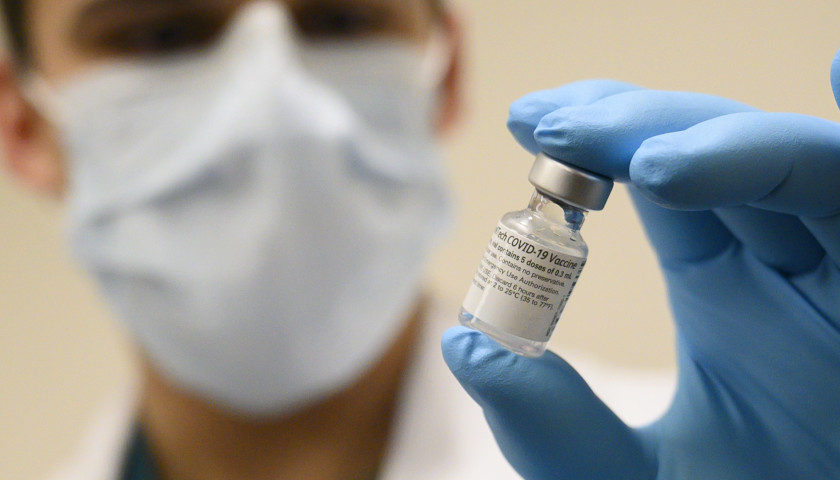Monday morning on The Tennessee Star Report with Michael Patrick Leahy – broadcast live from Music Row on Nashville’s Talk Radio 98.3 and 1510 WLAC weekdays from 5:00 a.m. to 8:00 a.m. – Leahy was joined on the newsmakers line by the all-star panelist Crom Carmichael.
During the second hour, Leahy and Carmichael discussed the recent remarks by Dr. Fauci about the number of cases to expect in the U.S. and how economically, they expect to see a sharp decline on the V graph by end of the second quarter and then a gradual increase by third quarter’s end.
Carmichael noted that 2020’s third quarter won’t be nearly as good as 2019. Nearing the end of the segment, Leahy touched upon the new FDA approved an N-95 mask recycling program that will be implemented to reuse 80,000 ventilators.
Leahy: We are joined now by the original all-star panelist Crom Carmichael. Crom, the President said all these social distancing regulations and requirements will now be in place till April 30th.
And that he thinks and experts think that the peak in the number of deaths will occur in about two weeks. About 2,000 people have died. Anthony Fauci has said that he thinks that the models predict that 100,000 to 200,000 could die. What do you make of it Crom?
Carmichael: Well we are clearly in unchartered territory. We’re going to have an economy in the last half of March and all of April that will operate at somewhere around 40% or 30% at capacity. And I’ve talked to a friend of mine who is in the automobile business. And in February he sold 220,000 and in March he sold 110,000 and most of that was in the first half of March.
The automobile business is going to be and every industry other than food and healthcare looks like it’s going to be dramatically affected. So, that would obviously include all the advertising platforms also because there isn’t enough commerce to support much in the way of advertising.
Leahy: Yeah. Everything’s going to stop I think pretty much for the next 30 days in terms of normal ways of doing business. Grocery stores will still be at work. You go in a grocery store and there’s a lot of activity going on there.
And of course, you have your convenience stores, gas stations, and pharmacies they are open. Hospitals are open. There’s not much of anything else open Crom. If you look at your crystal ball do you see anything? And what do you see? Because most of us and I would be put in that category, see an awful lot of uncertainty.
Carmichael: Oh good gosh the uncertainty, that would be an understatement. I mean we literally saw them projecting the second quarter that will have a 25% contraction. And In 2008 and 2009 the economy dropped six to seven percent? It was a deep deep deep recession.
So 25% of what the federal government has done is pumping four trillion dollars into the economy in a period of time that will start just about now. They may have pumped some in already but the vast amount of it will start this week and will run for the next 10 weeks.
Leahy: I went to the model that Dr. Deborah Birx talked about yesterday. Its a model called the IMHE-model out of Washington state. And that’s the one Dr. Fauci was referring to. I looked at it and here’s what it said.
It anticipated between now and June first that the bell curve will peak around the country in about two weeks and then it will continue to decline until about June first. But according to this model 81,000 people will die during that period of time according to this model.
Carmichael: Right.
Leahy: When President Trump talks about us being at the bottom of the hill, that would be June first. Let’s say that the first case scenario happens. People talk about the economy going deep down and then rapidly up in a sort of V shape. If that is how this pandemic plays out do you think a V-shape recovery is what we would see?
Carmichael: A V from a purely technical standpoint of the decline of the one-sided V is paired to an incline on the other side of the V of an equal slope. That’s not what we will see. We’re going to see a decline that is very very steep and then we’ll see an incline that may be half as steep as the decline. If we have a 25% drop in the second quarter than we’ll probably have another drop in the third quarter because they compare one quarter to the same quarter of the year before.
Leahy: Yeah. Gotcha.
Carmichael: The third quarter will be better than the second quarter but it would be nearly as good as the third quarter of last year. Second-quarter will be the worst.
Leahy: So the second quarter ends June 30th. And then the third quarter ends on September 30th. And the election is the first week of November. You know I look at this Crom and its awfully hard when we’re looking at literally the survival of the economy to spend too much time thinking about November. At what time do you think that will start to kick in?
Carmichael: Probably after the true threat of the coronavirus is passed. Whatever time that is. And I’m not sure when that is. If this virus is affected by heat then by June first we will clearly be passed the major threat. Or if we find a treatment that works really well then we’ll be past the threat.
The other thing that will be in place by the end of April and this will probably be true by the middle of April is all of the medical supplies that are in short supply now will be in plentiful supply by the middle of April.
Leahy: They are rushing to be ready to have those supplies ready. The respirators. The ventilators. ICU beds. They’re rushing to get them all in place by the peak which they think we’ll be mid-April.
But what’s interesting about that Crom and what looks like to me is not all of the country is going through this level of challenge to breaking the healthcare infrastructure. It seems to be concentrated right now Crom just in three geographical locations. Metropolitan New York. Metropolitan Detroit, and Metropolitan New Orleans.
Carmichael: Well I think there are some other areas. I think Chicago is experiencing some stress. California is experiencing some stress. And the state of Washington is experiencing some stress. Now, the equipment that I think will be in place hopefully by the end of this week and maybe even sooner is masks and gowns for the healthcare workers. For nurses and doctors.
Leahy: The N-95 masks.
Carmichael: Yes.
Leahy: There was a development on that over the weekend and in Ohio governor DeWine held an emergency press conference and called the FDA reckless for not approving immediately a product that the Battelle Laboratories had put together. But its a machine that can make up to 80,000 used respirators today and clean them up so they can be reused.
Carmichael: You mean masks?
Leahy: Yeah. Masks. They call them N-95 respirators.
Carmichael: OK. Excuse me. OK.
Leahy: Anyways basically they can recycle up to 80,000 a day of these in each unit. They’ve got one in Ohio. They’ve built one in New York. So that’s been approved by the FDA. So that I think should lessen the equipment problems there.
And I think you are right, each day the private sector is developing the capacity to deliver the masks, the respirators, the personal protection equipment, and the ventilators which are so desperately needed if we reach the peak.
Carmichael: The healthcare equipment for the nurses and the doctors that is the most critical. Because if we haven’t reached the peak yet then the healthcare nurses and doctors need to have protection above all others.
Leahy: Exactly.
Carmichael: I guess we’ll watch it almost on a daily basis. It will probably take a trend of a week to know if there is a real change in trend.
Leahy: Exactly.
Carmichael: But Nashville I think we’re doing our social distancing here. And so I don’t think that the problem will become a widespread problem here.
Leahy: We’ll see.
Listen to the full second hour here:
– – –
Tune in weekdays from 5:00 – 8:00 am to the Tennessee Star Report with Michael Patrick Leahy on Talk Radio 98.3 FM WLAC 1510. Listen online at iHeart Radio.





